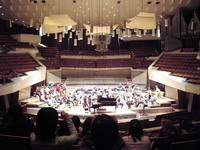Berlin Philharmonic starts its trip from gritty part of New York City
It was not Carnegie Hall.

The Berlin Philharmonic flew into town, and one of the first stops by some of its musicians was a gritty part of New York City.
A five-member wind ensemble played an hour-long program that included Mozart and American blues at the Salvation Army in Chinatown.
Spectators squeezed into the pews of a tiny chapel, where the world-class musicians played free of charge, in sweltering heat under a worn red velvet curtain.
"We're here to tear down the walls of 'high art' - to broaden the reach of the people," Berlin horn player Fergus McWilliam said later. "We are not high priests of music."
The program was just one of the tableaux from "Berlin in Lights," a 17-day festival that has brought artists from the German metropolis all over New York City. Offering classical and popular music - from ethnic Turkish to cabaret, plus dance, film, architecture, literature and photography - the Berliners have come with an attitude they believe is fit for audiences of the future.
"Our plan for the 21st century is to come out of the ivory tower and go to the community, instead of waiting for people to come to us," said the Scottish-born McWilliam. "We are an elite institution with the resources to make a difference."
Through Sunday, the Berliners are taking not only Manhattan but the Bronx and Staten Island, too. Its members are playing everywhere from Carnegie Hall to a restaurant, a park, a school and an art gallery - morning, noon and late into the night.
On Tuesday, Wednesday and Friday, the full orchestra under the baton of Simon Rattle was scheduled to play at Carnegie.
"Berlin in Lights" was organized by Carnegie Hall, with a one-week Philharmonic residency as its centerpiece, and more than 50 events offering snapshots of cultural life in the German capital since the Berlin Wall was torn down in 1989.
"With great music-making at its center, the festival examines a fascinating city reborn with the reunification of Germany - one that has reinvented itself in our lifetime and largely reshaped its identity through culture," said Clive Gillinson, Carnegie's executive and artistic director.
On Monday, jet-lagged from their trans-Atlantic flight a day earlier, Philharmonic players offered two afternoon neighborhood concerts.
At 1 p.m., McWilliam and seven fellow horn players stood at the altar of St. John the Divine Cathedral, playing to a standing-room-only audience of hundreds. Spectators old and young, even babies and toddlers, represented just about every ethnicity and socio-economic level in the city.
By 5 p.m., McWilliam joined a flutist, an oboist, a clarinetist and a bassoon player for the Salvation Army program.
"We're really having a good time!" McWilliam told the capacity audience that spilled out the door onto the sidewalk.
"This is very gratifying," he said later, glancing at more than 100 people who filed out of the chapel back onto the Bowery sidewalk, where they brushed shoulders with a group of homeless men waiting for beds for the night at a drop-in center.
It all began in 2002, when the Berlin Philharmonic decided to widen the orchestra's reach to spectators with little or no interest in classical music, all over the globe.
Rattle had brainstormed with his musicians to create the musical missionary work.
They enlisted the help of the Simon Bolivar Youth Orchestra of Venezuela and its charismatic 26-year-old conductor, Gustavo Dudamel. Dudamel, who becomes music director of the Los Angeles Philharmonic at the end of next season, led the youth orchestra in his New York conducting debut at Carnegie on Sunday.
Backed by the German government and Deutsche Bank, Rattle found an artistic soulmate in Carnegie's late executive director, Robert Harth, and together, they planned New York performances of Stravinsky's "The Rite of Spring" - a pagan-themed piece written a century ago that was so shocking it set off a riot in the elite Paris audience of the time.
This weekend, the piece will end the festival - first at Carnegie, for a paying audience, then on two evenings in Manhattan's mostly Hispanic Washington Heights neighborhood, with about 200 schoolchildren dancing with the Berlin Philharmonic playing the work that once shook the world.
Subscribe to Pravda.Ru Telegram channel, Facebook, RSS!




